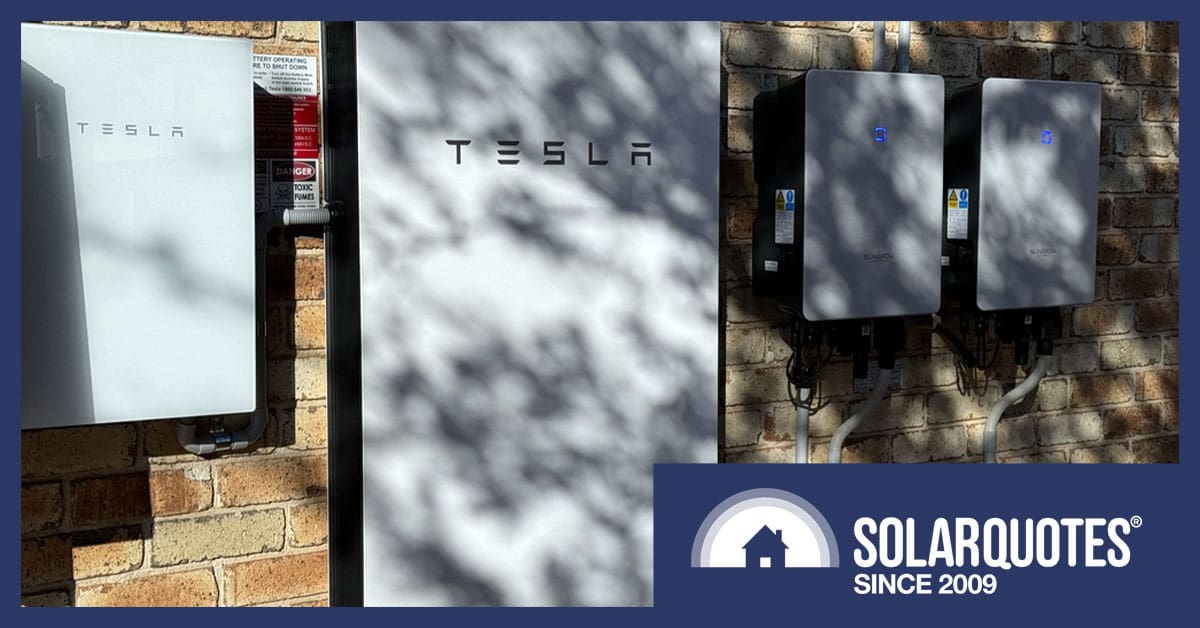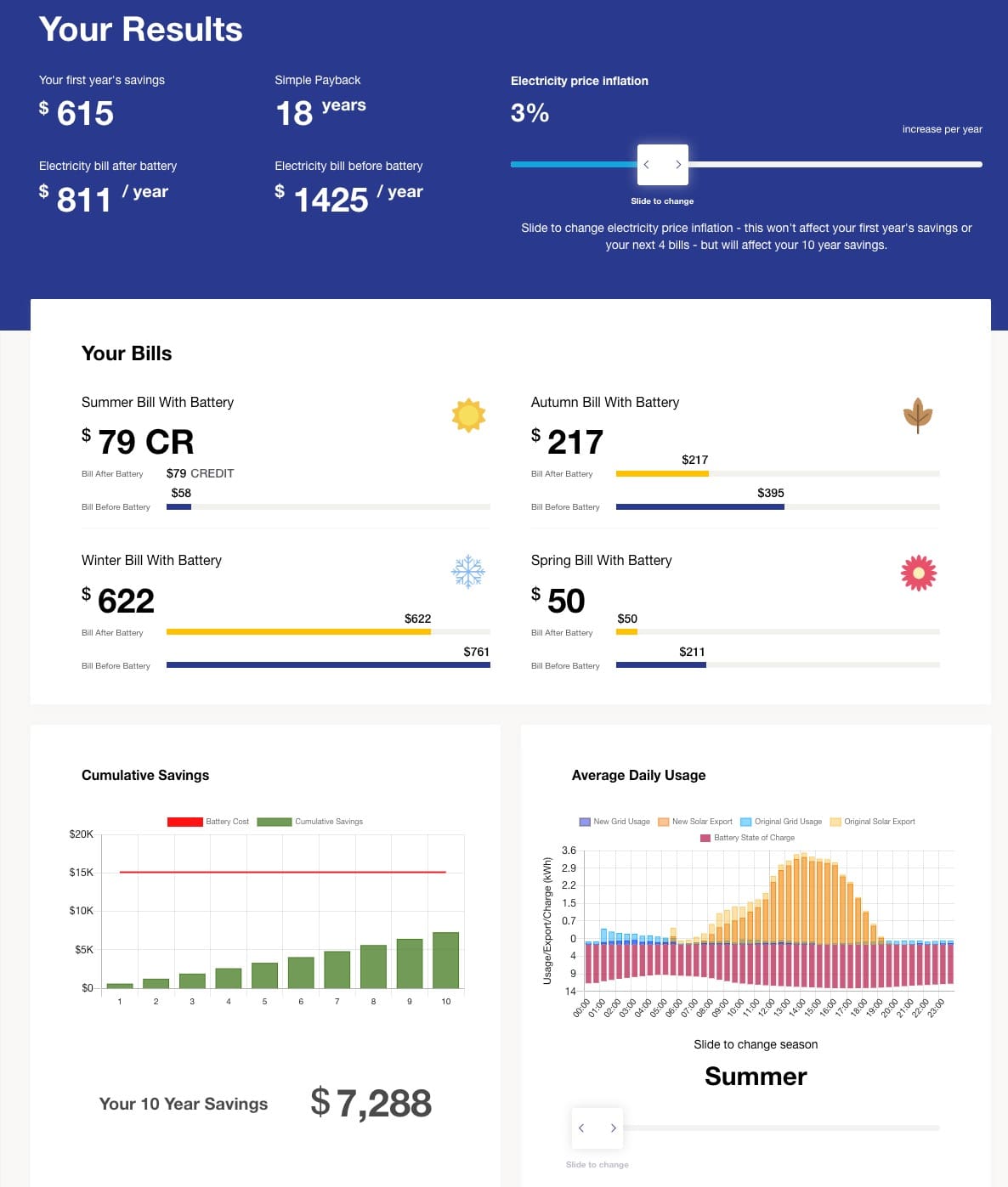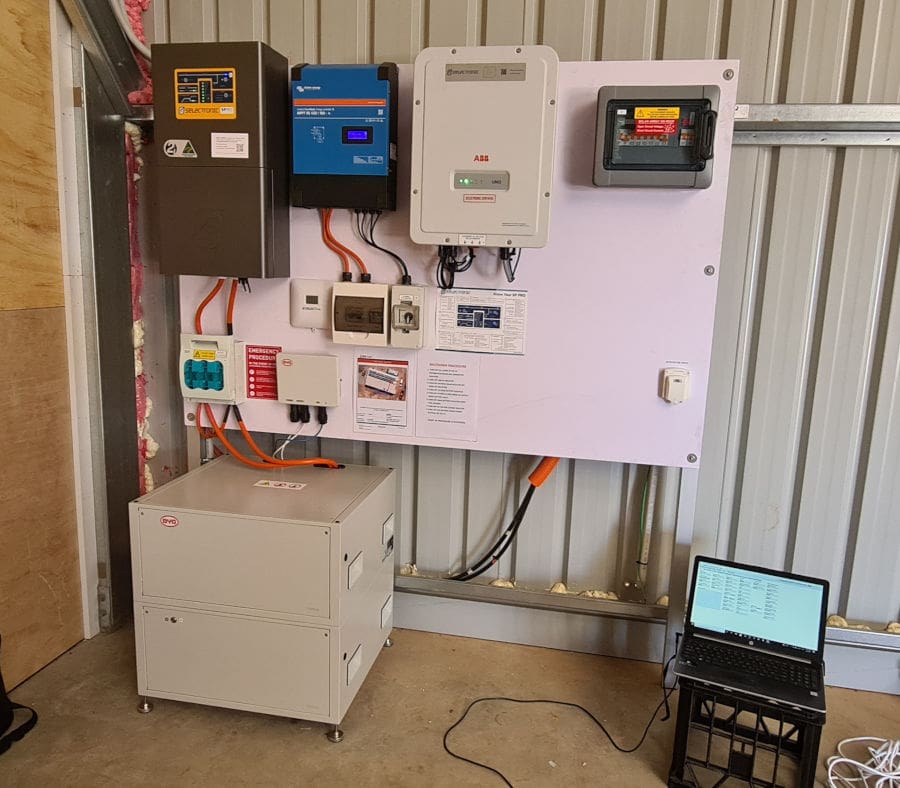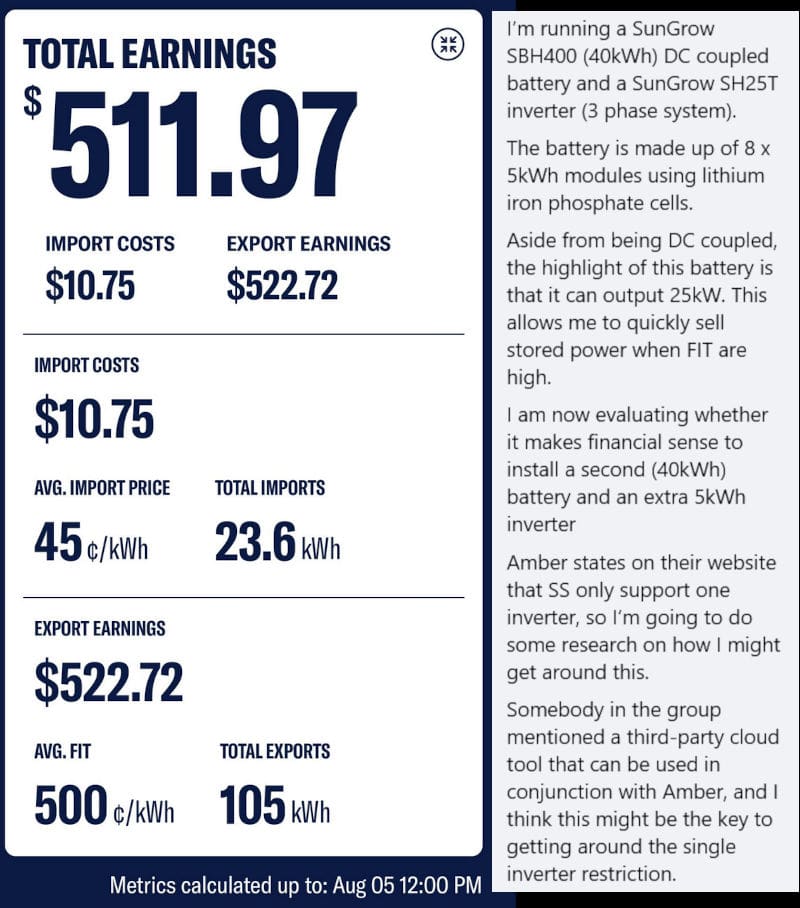
It’s been eight years since SolarQuotes first talked about what to look for in “battery-ready” solar power systems. A lot has changed since then, and many of you have been asking for an update.
Here’s what you need to know about buying battery-ready solar in 2024:
- There are more battery-ready brands at more price points.
- Three-phase backup is better catered for.
- Whole home backup is more feasible (not just essential circuits)
- If you choose the right battery/inverter, you now have options for energy trading, not just sef-consumption
And most importantly…
Battery Payback Is Improving
For years we recommended adding more solar and hunting good retail electricity tariffs as a better way to save money than a home battery.
In 2016, if you were:
- paying 24c per kWh for grid electricity
- and earning 16c per kWh with your Feed-In Tariff,
…the 8c per kWh you could save by storing your solar made a multi-decade battery payback common.
However, now electricity prices have risen, and feed-in tariffs have dropped, the growing gulf between the value of electricity imports and exports has pushed battery payback as low as six years in some cases.
Batteries work best when charged with excess solar. In 2016, Finn would tell you it was madness to buy a battery if your solar was not big enough to charge the battery all year long. But in 2024, with the right retail electricity deal, people are putting big batteries on small solar systems and charging using electricity at 8 cents per kilowatt hour. It’s great news for those with small or shaded roofs, but I’ve gotta add: nothing’s as reliable as sunrise.
How To Estimate Battery Savings Accurately
For a straightforward answer to battery payback in 2024, request NEM 12 data from your distributor and upload it to our new SolarQuotes battery calculator. Provided you already have solar, and a retail smart meter, you can use this tool to really flesh out the economics of a battery at your place.

Our ‘add-a-battery’ calculator uses your smart meter data to estimate real-world savings.
All Solar Power Systems Are Battery Ready*
There are two ways to add a battery:
- AC Coupling
- DC Coupling1
AC Coupling Makes Every Home Battery Ready
If you choose the venerable Tesla Powerwall 2 or any other AC-coupled battery, you can retrofit batteries to your existing solar panels no matter when they were installed or what inverter you have.
It’s so flexible, you can even add an AC-coupled battery to a house without solar.
So, if you are buying solar now and want to add batteries later, rest easy—AC coupling is always an option for you (but check with your solar installer about local grid connection rules on inverter sizing and that you have a suitable location to add a future battery).
But DC Coupling Has Many Advantages
If AC coupling is so retrofittable, why bother with DC coupling, which requires installing a special hybrid inverter that a battery can plug into later?
Because:
- A battery installation will be quicker and cheaper if your installer plugs the battery into a properly installed hybrid inverter.
- The hardware for a DC-coupled system is usually slightly cheaper, with one inverter handling both the solar and battery.
- If you have three phases, a three-phase hybrid inverter is the best value way to back up your whole house.
- DC coupling allows you to put more solar panels on your roof than you would otherwise be allowed.
- Brands like GoodWe & Fronius offer hybrid inverters for the same price as a standard solar inverter. You only pay $600-$1000 to upgrade the inverter’s software when you’re ready to add the battery.
But hybrid inverters aren’t all sunshine and lollipops…
Plan For Obsolescence
The solar industry moves fast.
A “battery-ready” system with a hybrid inverter bought eight years ago could easily be obsolete now, which means there are no compatible batteries available. Many battery brands simply move on to the next model, so it’s essential to budget to buy your battery within a couple of years.
For example, BYD ceased producing some models suitable for SMA, GoodWe, SolaX, and Victron inverters, which means you can’t add or expand those batteries anymore.
And AC-coupled batteries aren’t immune: in 2016, Australia was the first market for the tiny 1.2kWh/260watt output Enphase AC Battery. Being modular meant extra units could be installed. However, these days, any expansion will hinge on finding some second-hand units.
Off Grid Is Different
If you want to go off-grid when you finally add a battery, different rules apply.
Whereas on-grid inverters like Sungrow have abandoned low-voltage batteries in favour of high-voltage systems with higher efficiency and less copper, 48 volts is still king for off-grid, remote-area power. With building blocks based on a standard battery voltage, you’re not tied to a particular battery brand or model.
Network permission for an off-grid inverter as a grid-connected hybrid will vary; however, where they excel is simple reliability and outright guts. Plus using DC solar regulators for battery charging, you can install virtually unlimited solar.
When overloaded, modern lightweight hybrids might deliver 120% for 10 seconds, whereas proper off-grid machines will surge to 240% without raising a sweat.

Selectronic, Victron, ABB inverters and BYD batteries are all playing happily. However, these off-grid systems aren’t plug-and-play, so cheap chumps don’t know how to install them.
Staying On-Grid Enables Energy Trading
If you stay on-grid, it is now possible to export your battery energy to the grid, maximising your economic return.
Tesla, AGL, Origin and others offer Virtual Power Plants, meaning you can become a small part of a large generator on the National Electricity Market. If there’s a grid event that requires the use of your battery, you’ll get a credit on your bill.
Smartshift from Amber offers wholesale import prices plus bonus payments for exporting energy from your battery when the market is hot, so there are some attractive reasons to have a genuinely smart system on your wall.
If you want to join one of these services, you’ll want to buy compatible hardware that is either programmable via an app or integrated with the retailer using an Application Programming Interface (API).
Check the VPP operator or electricity retailer’s site before you buy your battery to see which ones are compatible, but SolarQuotes-approved brands Tesla, Sungrow and SolarEdge batteries seem to be compatible with most VPPs and retailers.

Credit: MEEH Facebook page. While this earning might seem spectacular, there’s $40,000 invested in solar & battery to capture this rare grid event. Ordinary returns will be far more modest
When You’re Battery Ready
Remember, your budget may curb your ambition, so get advice on what’s possible. Some batteries are very modest, some don’t work in an outage, and others won’t black start if you run them flat, so work out your preferences and document your expectations.
Hopefully, this post is a helpful update to the 2016 original. If you’re looking to buy a battery-ready solar system and still have questions, let me know in the comments.
Or, if you want to get cracking with quotes from battery installers we trust, you can do that here.

 RSS - Posts
RSS - Posts



Great article Anthony.
I have 1 question please.
Background: Re putting more panels than an inverters rating. I was told by a company that Sungrow hybrid ( and others i assume) can use PV solar production above the Inverter’s rating if a battery is connected. I.e. for 10kw hybrid inverter with 15kw solar pv in perfect conditions, could theoretically be powering house loads and o exporting FiTs with 10kw and charging battery with the other 5kw of solar production.
Q: can Fronius gen24+ hybrid inverters output $150% of nameplate rating if got a battery and enough solar PV? I msged Fronius and no reply and no-one else i know can confirm that it can or cannot.
Hi Lyle,
Fronius specify 150% connected solar so anything above that might endanger your warranty. It shouldn’t blow the inverter up immediately, (unless they connect too many panels in series and push the voltage too high) but you’d have to do the experiment yourself without claiming STC credits.
Fronius are however very good at managing energy no matter where you need it. They call it multiflow technology and yes it means you can be using solar to charge your battery while maintaining full AC output to the grid or the house.
https://www.fronius.com/en-au/australia/solar-energy/installers-partners/products-solutions/features/multi-flow-technology
As for Sungrow and your hypothetical, I have 10kw hybrid and 13kw of PV and have seen in excess of 10Kw being powered to battery home and grid, As you allude to battery charging with a hybrid is DC – DC and not related to the AC limitations [10kw] of the inverter. It seems to me that theoretically it would be possible to charge battery, power house and feed in to grid in total in excess of the Inverter spec which would limit the aggregate of the feed in and house consumption. Mind you, my roof never experiences anything link laboratory conditions and is NNW facing with a pitch of about 30 degrees, as close to ideal as you can get.
Sungrow 10kw single phase is rated for 200% panels with a battery. Im guessing if you put up say 15kw of PV there would be lots of times when there is overdrive PV to use for battery charging. My system is small so a lot of load management . Turnoff HWS to charge the EV etc . Having a 10kw system with 5 kw usable overdrive would be heaven!
The only future proof expansion option is 48 V architecture due to its ubiquity. It’s a crying shame there are no voltage and comms control standards insisted on for grid tied battery systems. It would go a long way to help prevent the obsolescence issue. Everyone wants a closed shop so they can rip you off.
I think in our next home I’ll stick with a 48 V system using 16S LiFePO4 modules. You can just pretty just much add capacity as and when you see fit and without the hassle of placing old and new modules in series.
Alex,
When going the 16S LiFePO₄ cell path, I’ve found the “JK” (Jikong) BMS easy to install, configure, and monitor on the mobile phone. The one with integral 2 amp _active_ balancer is keeping my 304 AH cells trim. Max cell imbalance on the 3 banks is 9, 17, and 32 mV respectively at rest tonight.
I have 3 spare “5 amp” active balancers in original boxes – they proved unnecessary.
The BMSs are cheaper from China, but I bought locally, for warranty.)
I wasn’t game to buy the cells from China either, so only saved 2/3 the cost of commercial batteries. With the recent LiCO₃ price crash, and GWh of grid batteries being produced now, the cells are very low cost now. (I’ve heard US$40/kWh for grid scale OEMs.) Even for DIY, I expect them to come down ten time faster than solar panels did … but wouldn’t want to wait for the same to happen with commercial domestic scale batteries.)
Off-grid here, my only “export” is EV charging. That has saved around $800 in 6 months – $1600 p.a. That sounds competitive with grid export, and could easily be tripled if I had more cars and drivers.
Hi Eric,
Where did you source your hardware? While we can’t recommend much DIY electrical in Australia there are many who use this sort of gear for 12 volt applications in vehicles. While directly imported gear via mail order is cheap, it would be good to have an Australian supplier who offers support and warranty.
Hi Anthony,
I bought mine from up in Queensland: https://lifepo4.com.au/
Ernest Brindley uses what he sells, so is good for a quick chat on options and expectations. Revisiting the site, it looks like there’s now a simple way
to avoid the arc flash risks and BMS installation complexity on assembly of a DIY battery bank. They now also have boxed 16 kWh banks, ready to go:
https://lifepo4.com.au/shop/victron-2/51-2v-314ah-16kwh-eve-8000-cycles-lifepo4-battery/
So prices are coming down if you shop around. And your solar installer would then hook them up to the MPPTs and inverters on the wall with minimal labour involved. I haven’t tried these, but the on-line ad says “EVE A+ Grade”, and EVE brand is what I sought out for my self-built banks – they’re as good as CATL, I think, and my 48 cells are performing well. I see they discount for a 5 year warranty, but the 10 year warranty seems a comforting option.
Lower on the page, there’s mention of JBD or JK BMS. The JBD is OK too, but I find the JK easier to manage via the phone app. Ask them if their JK is the version with 2 amp active balancer – it’ll better maintain battery health over time. The warning about inferior stuff off Alibaba is consistent with my concerns, after seeing some buyer’s regret on YT, from folk chasing ultimate bargains off the net.
When buying two, I’d maybe prepay one for the better price, and post pay the other. (And 32 kWh will be the new rational minimum within a year, just watch. I admit my 46 kWh is a tad super-adequate, but an aquaintance is installing 80 kWh, also off-grid.)
Call me a privileged baby boomer, but it seems that the excuses for not having a battery to time-spread solar self-consumption are diminishing at a good clip now.
Just a note, the very article you link to when you say “DC coupling allows you to put more solar panels on your roof than you would otherwise be allowed” notes that this limitation has been removed and you can now install panels up to the inverter manufacturer’s maximum oversizing and claim STCs even with an AC coupled battery.
Good point Mark,
I should also add that when using DC regulators to directly charge a battery, like a traditional off grid system, you can have virtually unlimited solar without breaching any network rules or needing any permission.
Anthony,
Is there a limit of 100 kW PV array for small scale credits? That’s near as dammit unlimited for domestic purposes, I freely admit, and hard to find a use for, until a home fast EV charger comes along at an affordable price.
But when electric tractors finally show up, being able to put 50 – 100 kWh into one while stopping for lunch would be just the thing.
With the Xpeng flying EV appearing at the Melbourne show last weekend, and Robotaxis around the corner, once EV tractors proliferate, the transport energy economy will be unrecognisable. My brother insists on buying a PHEV, due to slow growth of charging infrastructure, but they’re not EVs, still cost money to run after the first 80 km, need oil changes and all that ICE maintenance, and have a _lot_ more ironmongery to go bung.
Even if the looming middle east war does not materialise, and the Houthies calm down, fossil fuel prices have only one way to go. Buying anything which relies on the stuff seems a dubious investment. There’s an Aramco-backed hydrogen-to-synthetic aviation-fuel demonstration plant starting up in the UK, but enough for mass aviation alone has to be decades away.
Incidentally, a big domestic battery is ideal for more quickly charging the EV on a deeply overcast day when you’ve been slow to remember the wife’s birthday, and there’s no option but the 65 km return trip to town.
P.S. “Notify me of follow-up comments by email.” is still broken, so it takes determination to go back and check manually whether a reply is needed.
Yes Eric,
100kW is where STCs stop and you move to LGCs, where the actual yield is measured and you get paid each year for what you produce, not just an up front incentive based on deeming.
I suspect electric tractors will be a good use case for swappable batteries. You don’t need a header for 9 or 10 months of the year so moving that battery seasonally would make sense.
I saw recently that the DEYE hybrid is a CEC certified inverter that can take most types of 16s batteries and has can bus direct coms to a variety of 48v rack batteries or 16s BMS.
Currently on an EV plan (8c kWh 00:00 – 06:00 & 0c kWh 11:00-14:00)
Is it worth waiting for the PowerWall 3 since it has a built-in inverter & can handle multiple strings (planning on more panels on the west side of the roof)?
Hi Steve,
PW3 is being launched very soon but aside from conjecture we can’t really say until then.